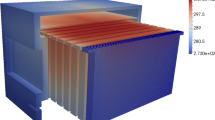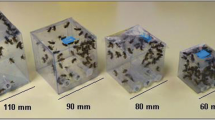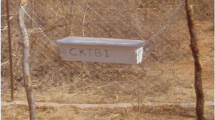Abstract
In the absence of human intervention, the honeybee (Apis mellifera L.) usually constructs its nest in a tree within a tall, narrow, thick-walled cavity high above the ground (the enclosure); however, most research and apiculture is conducted in the thin-walled, squat wooden enclosures we know as hives. This experimental research, using various hives and thermal models of trees, has found that the heat transfer rate is approximately four to seven times greater in the hives in common use, compared to a typical tree enclosure in winter configuration. This gives a ratio of colony mass to lumped enclosure thermal conductance (MCR) of less than 0.8 kgW−1 K for wooden hives and greater than 5 kgW−1 K for tree enclosures. This result for tree enclosures implies higher levels of humidity in the nest, increased survival of smaller colonies and lower Varroa destructor breeding success. Many honeybee behaviours previously thought to be intrinsic may only be a coping mechanism for human intervention; for example, at an MCR of above 2 kgW−1 K, clustering in a tree enclosure may be an optional, rare, heat conservation behaviour for established colonies, rather than the compulsory, frequent, life-saving behaviour that is in the hives in common use. The implied improved survival in hives with thermal properties of tree nests may help to solve some of the problems honeybees are currently facing in apiculture.



Similar content being viewed by others
References
Anderson EJ (1948) Hive humidity and its effect upon wintering of bees. J Econ Entomol 41(4):608–616. doi:10.1093/jee/41.4.608
Bogdan M, Hoerter J, Moore F (2005) Meeting the insulation requirements of the building envelope with polyurethane and polyisocyanurate foam. J Cell Plast 41(1):41–56. doi:10.1177/0021955X05049869
Buttemer WA (1985) Energy relations of winter roost-site utilization by American goldfinches (Cardue/is tristis). Oecol (Berlin) 68:126–132. doi:10.1007/BF00379484
Chen Y et al (2012) Nosema ceranae infection intensity highly correlates with temperature. Invertebr Patholol 111(3):264–267. doi:10.1016/j.jip.2012.08.014
Coombs AB, Bowman J, Garroway CJ (2010) Thermal properties of tree cavities during winter in a northern hardwood forest. J Wildlife Manag 74(8):1875–1881. doi:10.2193/2009-560
Crane E (1990) Bees and beekeeping. Heineman, Oxford
Cushman D. (2011) Drawings of hives and hive parts. http://www.dave-cushman.net/bee/britparts.html. Accessed 11 Jan 2014
de Jong D, Goncalves LG, Morse RA (1984) Dependence on climate of the virulence of Varroa jacobsoni. J Apicult Res 65(3):117–121
Delaplane KS, van der Steen J, Guzman-Novoa E (2013) Standard methods for estimating strength parameters of Apis mellifera colonies. J Apicult Res 52(1). doi: 10.3896/IBRA.1.52.1.03
Doull KM (1976) The effects of different humidities on the hatching of the eggs of honeybees. Apidologie 7(1):61–66. doi:10.1051/apido:19760104
Erdogan Y (2009) Some physiological characteristics of honeybee housed in heated fan wooden and insulated beehives. J Anim Vetinary Adv 8(8):1516–1519
Erickson EH (1990) Stress and honey bees. Gleanings Bee Cult 118(11):650–654
Even N, Devaud J-M, Barron AB (2012) General stress responses in the honey bee. Insects 3:1271–1298. doi:10.3390/insects3041271
Flores J.M. (2011) Temperature and climate in chalkbrood disease presentation to Coloss committee. http://www.uco.es/dptos/zoologia/Apicultura/Power_Point_Apicultura/Temperature_and_climate%20_chalkbrood_disease.pdf. Accessed 22 Jan 2014
Flores JM et al (1996) Effect of temperature and humidity of sealed brood on chalkbrood development under controlled conditions. Apidologie 27(4):185–192. doi:10.1051/apido:19960401
Fornito L, Lee R, Tajchman SJ (1982) Heat transfer models for nesting cavities. J Arch Meteorol Geophys Bioclimatol 30(3):271–282. doi:10.1007/BF02323367
Franck P, Garnery L, Solignac M, Cornuet J-M (1998) The origin of west European subspecies of honeybees (Apis mellifera): new insights from microsatellite and mitochondrial data. Evolution 52(4):1119–1134. doi:10.1002/ece3.312
Free JB, Racey PA (1968) The effect of the size of honeybee colonies on food consumption, brood rearing and the longevity of the bees during winter. Ent Exp Appl 11:241–249
Furgalau B, McCrutcheon DM (1992) Wintering productive colonies. Hive HoneyBee 849
Guzman-Novoa E, Eccles L, Yireli CY, Mcgowan J (2010) Varroa destructor is the main culprit for the death and reduced populations of overwintered honey bee (Apis mellifera) colonies in Ontario, Canada. Apidologie 41(4):443–450. doi:10.1051/apido/2009076
Hagenmaier RD, Shaw PE (1992) Gas permeability of fruit coating waxes. J Am Soc Hortic Sci 117(1):105–109
Hossam FA (2012) Tolerance of two honey bee races to various temperature and relative humidity gradients. Env Exp Biol 10(4):133–138
Huang Z (2012) Varroa mite reproductive biology. Am Bee J 140(10):981–985
Human H, Nicolson W, Dietemann VV (2006) Do honeybees, Apis mellifera scutellata, regulate humidity in their nest? J Naturwissenschaften 93(8):397–401. doi:10.1007/s00114-006-0117-y
Incropra, DeWitt, Bergman & Lavine (2006) Fundamentals of heat and mass transfer. Wiley
Kraus M, Kubečková D (2013) Airtightness of energy efficient buildings. 1st Ann Int Conf Archit Civil Eng 29–35. doi: 10.5176/2301-394X_ACE13.10
Kraus B, Velthuis HHW (1997) High humidity in the honey bee (Apis mellifera L.) brood nest limits reproduction of the parasitic mite Varroa jacobsoni. Naturwissenschaften 84:217–218. doi:10.1007/s001140050382
Lawrence MG (2005) The relationship between relative humidity and the dewpoint temperature in moist air. Am Meterol Soc 86(2):225–233. doi:10.1175/BAMS-86-2-225
Lin YJ, Xu ZY (2013) Buoyancy-driven flows by a heat source at different levels. Int J Heat Mass Tran 58:312–321. doi:10.1016/j.ijheatmasstransfer.2012.11.008
Linden PF (1999) The fluid mechanics of natural ventilation. Ann Rev Fluid Mech 31:201–238. doi:10.1146/annurev.fluid.31.1.20
Mayack C, Naug D (2008) Energetic stress in the honeybee Apis mellifera from Nosema ceranae infection. J Invertebr Pathol 100(3):185–188. doi:10.1016/j.jip.2008.12.001
Maziarz M, Wesołowski T (2013) Microclimate of tree cavities used by great tits (Parus major) in a primeval forest. Avian Biol Res 6(1):47–56. doi:10.3184/175815513X13611994806259
Microchip Inc (n.d.) TCN75A 2-Wire serial temperature sensor. http://www.microchip.com/downloads/en/DeviceDoc/21935D.pdf. Accessed 11 Jan 2004
Mlakar J, Štrancar J (2013) Temperature and humidity profiles in passive-house building blocks. Build Environ 60:185–193. doi:10.1016/j.buildenv.2012.11.018
Olszewski K (2007) Winter-hardiness of buckfast bees under specific weather conditions of areas with alternating influences of maritime and continental climate. J Apic Sci 51(1):73–82
Owens C (1971) The thermology of wintering honey bee colonies. US Agric Res Serv Tech Bull 1429
Ptáček V (2000) How many individuals survive winter in intact colonies of Apis mellifera L. (Hymenoptera, Apidae)? Pszczelnicze Zesz Nauk 44(2):15–22
Seeley TD (1985) Honeybee ecology. Princeton University Press, Princeton
Seeley TD, Morse RA (1976) The nest of the honey bee (Apis mellifera L.). Insect Soc 23:495–512. doi:10.1007/BF02223477
Simpson J (1961) Nest climate regulation in honey bee colonies. Science 3461:1331–1332. doi:10.1126/science.133.3461.1327
Southwick EE (1982) Metabolic energy of intact honeybee colonies. Comp BIiochem Phys B 71(2):277–281. doi:10.1016/0300-9629(82)90400-5
Southwick EE (1985) Allometric relations, metabolism and heat conductance in clusters of honey bees at cool temperatures. J Comp Physiol B 156:143–149. doi:10.1007/BF00692937
Stabenthiener A (2010) Honeybee colony thermoregulation—regulatory mechanisms and contribution of individuals in dependence on age, location and thermal stress. PLoS One 5(1). doi: 10.1371/journal.pone.0008967
Tamashbi GH (2009) The effect of temperature and humidity on grooming behaviour of honeybee. J Entomol Res Soc Iran 28:7–23
The Forest Products Laboratory (2010) The wood handbook. Madison: USDA. pp. 4-1-4–19
Thorkelson J, Maxwell RK (1974) Design and testing of a heat transfer model of a racoon (Procyon lotor) in a closed tree den. Ecology 55(1):29–39. doi:10.2307/1934615
Villa DJ (2009) Overwintering of Russian honey bees in northeastern Iowa. Sci Bee Cult 1(2):19–21
Villumstad E (1974) Importance if hive insulation for wintering, development and honey yield in Norway. Apiacta 9:277–281
Williams GR (2013) Standard methods for maintaining adult Apis mellifera in cages under in vitro laboratory conditions. J Apicult Res 52(1). doi: 10.3896/IBRA.1.52.1.04
Acknowledgments
The authors acknowledge the Paynes Southdown Bee Farms, Ltd.; Modern Bee Keeping, Ltd.; Bee Hive Supplies, Ltd.; Swienty Sønderborg Denmark; J. Haverson; D. Pearce; C.E. Mitchell; and Y. Hunt for the loan of test hives.
Author information
Authors and Affiliations
Corresponding author
Rights and permissions
About this article
Cite this article
Mitchell, D. Ratios of colony mass to thermal conductance of tree and man-made nest enclosures of Apis mellifera: implications for survival, clustering, humidity regulation and Varroa destructor . Int J Biometeorol 60, 629–638 (2016). https://doi.org/10.1007/s00484-015-1057-z
Received:
Revised:
Accepted:
Published:
Issue Date:
DOI: https://doi.org/10.1007/s00484-015-1057-z




